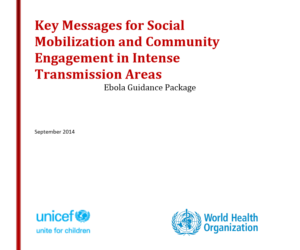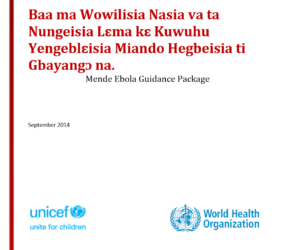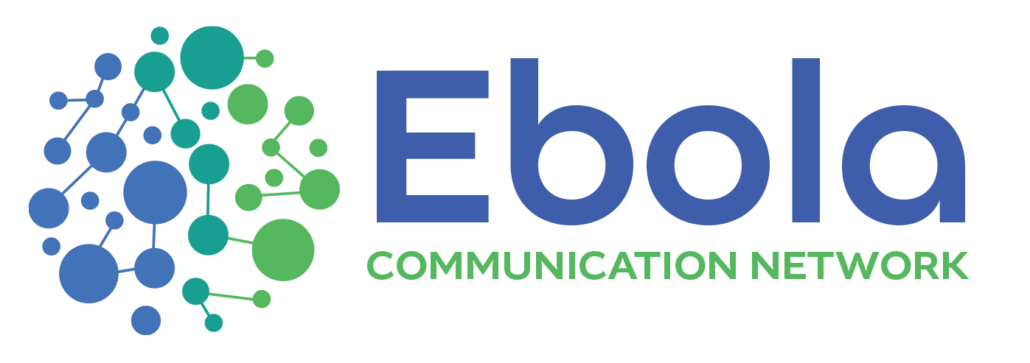Ebola Question and Answer Booklet
 This illustrated booklet addresses Frequently Asked Questions about EVD, including general facts, modes of transmission, prevention, treatment and common misconceptions.
This illustrated booklet addresses Frequently Asked Questions about EVD, including general facts, modes of transmission, prevention, treatment and common misconceptions.
Source: Ebola Q&A Booklet
 This illustrated booklet addresses Frequently Asked Questions about EVD, including general facts, modes of transmission, prevention, treatment and common misconceptions.
This illustrated booklet addresses Frequently Asked Questions about EVD, including general facts, modes of transmission, prevention, treatment and common misconceptions.
Source: Ebola Q&A Booklet
With more than half of the cases of the epidemic persistently registered in the Western Area District of Sierra Leone, and cases continuing to rise, in late November 2014, the need for the ‘Western Area Surge’ was established.
The overall goal of the Surge was to interrupt the alarming upward trend with intensive community engagement and improved service provision over the period 15th December, 2014 to 31st December, 2015 in order to break the chain of transmission.
The Surge was designed around the inter-dependence of supply and demand factors within the wider enabling environment. In the lead up to the Surge, it was evident that the supply side was not adequately delivering services. A lack of trust in the health system and the wider response had developed which undermined any further demand creation. Therefore, the first step in the Surge involved drastically increasing the quality and quantity of all services, and communicating this to build confidence and encourage the public to come forward at the earliest possible stage.
Supported and launched at the highest level, His Excellency the President, Dr. Ernest Bai Koroma, went on National television and radio on the evening of 18 September and declared a “sit at home” for the period from 19 to 21 September 2014 to facilitate the implementation of the nationwide House to House Family Sensitization Campaign. Council chairmen and traditional leaders replicated this symbolic launch with similar events at districts and chiefdoms across the country. The MOHS, in collaboration with UNICEF, WHO, other partners, and line Ministries, conducted the campaign.
The goals were to:
• Achieve community ownership and participation in the EVD response;
• Engage the community in contact tracing and mitigating transmission risk; and,
• Lay a foundation for health sector recovery via interactive confidence building.
The objectives of the campaign were to:
• Reach 100% of households in the country with correct information on EVD;
• Increase community acceptance of EVD affected persons, especially children;
• Promote hand washing with soap at the household level;
• Rebuild public confidence and trust in the health system; and,
• Install neighborhood watch structures at community level.
The “Hotspot Busters Initiative” was aimed at reducing and eliminating the spread of EVD in hotspot areas as soon as cases appeared. It became a key element of UNICEF’s response to the Ebola outbreak in Sierra Leone. UNICEF and the Ministry of Health and Sanitation (MOHS), in partnership with the Health for all Coalition (HFAC), a local community-based organization with a network of social mobilizers in the field, implemented this intervention at the ward level across the country.
How does Hotspot Busting work?
A hotspot was defined by HFAC as ‘any two suspected cases from a community’.
The activities of this initiative aimed to:
• Sensitize Paramount Chiefs and traditional leaders on the need for intensification of the EVD response in the hotspot communities, including dissemination of chiefdom by-laws on EVD;
• Undertake intense door to door community sensitization;
• Provide key messages via SBCC materials;
• Facilitate community referrals; and,
• Report on suspected cases.
These brief case studies reflect the contribution of numerous partners in the social mobilization pillar co-chaired by UNICEF and the Ministry of Health
This animation—produced in collaboration with International Federation of Red Cross and Red Crescent Societies, UNICEF, and Yoni Goodman—brings to life key messages that help people see and understand how Ebola spreads and how to protect themselves and their communities.

This document compiles current information and key messages about the Ebola outbreak in Liberia to inform activities designed to raise awareness, mobilize communities, and promote safe behaviors to stop the spread of Ebola in Liberia. |Download|
 The Knowledge, Attitudes and Practice (KAP) study was conducted between December 7th and 22nd, 2014, to gauge the success of social mobilization efforts to educate the general public on key Ebola prevention messages in the country. The study design included quantitative and qualitative components. A questionnaire survey from a representative sample of 1,140 households was conducted in 6 purposely selected counties (Montserrado, Grand Gedeh, Lofa, Nimba, River Cess and Grand Cape Mount). Counties were selected to cover a range in the timing and impact of the Ebola epidemic in different parts of Liberia. The qualitative component was included to provide social context, collective understanding, and evolving debates behind static survey responses. It consisted of a series of 28 focus group discussions among 224 men and women conducted around the same time period in the same six counties. Groups were divided by gender and urban-rural residence, with additional groups for those in professional occupations. The topic guide generally followed a similar structure to the survey questionnaire in order to facilitate comparison across both data sources.
The Knowledge, Attitudes and Practice (KAP) study was conducted between December 7th and 22nd, 2014, to gauge the success of social mobilization efforts to educate the general public on key Ebola prevention messages in the country. The study design included quantitative and qualitative components. A questionnaire survey from a representative sample of 1,140 households was conducted in 6 purposely selected counties (Montserrado, Grand Gedeh, Lofa, Nimba, River Cess and Grand Cape Mount). Counties were selected to cover a range in the timing and impact of the Ebola epidemic in different parts of Liberia. The qualitative component was included to provide social context, collective understanding, and evolving debates behind static survey responses. It consisted of a series of 28 focus group discussions among 224 men and women conducted around the same time period in the same six counties. Groups were divided by gender and urban-rural residence, with additional groups for those in professional occupations. The topic guide generally followed a similar structure to the survey questionnaire in order to facilitate comparison across both data sources.
National Knowledge, Attitudes and Practices (KAP) Study on Ebola Virus Disease in Liberia
 Handwashing demonstration/training materials fact sheet.
Handwashing demonstration/training materials fact sheet.
Always Wash Your Hands with Soap and Clean Water to Kill Ebola
 WHO/UNICEF Key Messages for Social Mobilization in Ebola Affected Countries translated in Krio by Translators without Borders.
WHO/UNICEF Key Messages for Social Mobilization in Ebola Affected Countries translated in Krio by Translators without Borders.
 WHO/UNICEF Key Messages for Social Mobilization in Ebola Affected Countries translated in Mende by Translators without Borders.
WHO/UNICEF Key Messages for Social Mobilization in Ebola Affected Countries translated in Mende by Translators without Borders.

The Ebola Communication Network was originally developed by the Health Communication Capacity Collaborative (Cooperative Agreement #AID-OAA-A-12-00058) and expanded under Breakthrough ACTION (Cooperative Agreement #AID-OAA-A-17-00017) both under the leadership of Johns Hopkins Center for Communication Programs. This website is now maintained by Johns Hopkins Center for Communication Programs and its contents are the sole responsibility of CCP. The contents of this website do not necessarily reflect the views of USAID, the United States Government, or Johns Hopkins University.
